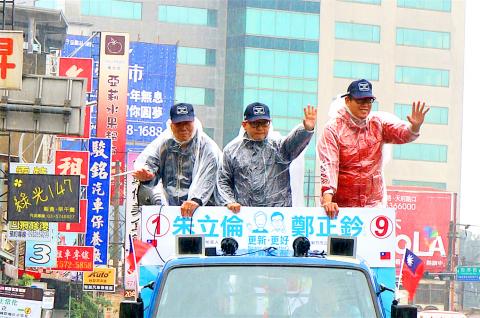Voter turnout for Saturday’s presidential election was the lowest of the six direct presidential elections since 1996, data compiled by the Central Election Commission showed.
Voter turnout in the election was 66.27 percent, compared with 76.04 percent in 1996, 82.7 percent in 2000, 80.28 percent in 2004, 76.33 percent in 2008 and 74.38 percent in 2012, the commission said.
The figures were released alongside the commission’s announcement late on Saturday that Democratic Progressive Party (DPP) Chairperson Tsai Ing-wen (蔡英文) had won the election.

Photo: CNA
Tsai and her running mate, Chen Chien-jen (陳建仁), received 6.89 million votes, or 56.12 percent of total valid votes, commission Chairman Liu Yi-chou (劉義周) said.
Tsai defeated Chinese Nationalist Party (KMT) candidate Eric Chu (朱立倫), who garnered 31.04 percent of the total vote, and People First Party (PFP) candidate James Soong (宋楚瑜), who received 12.84 percent of the vote.
In the legislative race, the DPP won 68 seats out of 113, up from 40 in the previous election four years ago, to give it an absolute majority in the legislature for the first time.
The KMT won 35 seats, sharply down from 64 in the previous election, the commission said.
The New Power Party (NPP) won five seats to become the third-largest party in the Legislative Yuan, followed by the PFP with three seats, the Non-Partisan Solidarity Union with one seat and an independent with the final seat.
The commission said voter turnout in single-member legislative constituency races was 66.58 percent, and 66.25 percent for the political party vote that determined the distribution of legislators-at-large.
Turnout was 57.66 percent for the vote for Aboriginal representatives in mountainous areas and 51.72 percent for the vote for Aboriginal representatives in low-lying areas.
Meanwhile, the commission said that five political parties that have each garnered more than 3.5 percent of the total number of votes cast in legislative elections are eligible to collect NT$50 per vote annually over the next four years, in accordance with the Civil Servants Election and Recall Act (公職人員選舉罷免法).
The New Party, which garnered 4.18 percent of the vote, would also receive subsidies, although it will not hold any legislator-at-large seats.
A record 18 political parties competed in the legislative election and four of them — the DPP, KMT, PFP and NPP — received more than 5 percent of the total votes, making them eligible to be allocated legislator-at-large seats and to receive the election subsidy, commission statistics showed.
It is calculated that the DPP would receive NT$268.54 million (US$7.94 million) each year, given that it garnered more than 5.37 million votes in the legislative election, while the KMT can claim NT$164.04 million and the PFP NT$39.74 million.
The NPP would be eligible to receive NT$37.21 million per year and the New Party NT$25.5 million.

An essay competition jointly organized by a local writing society and a publisher affiliated with the Chinese Communist Party (CCP) might have contravened the Act Governing Relations Between the People of the Taiwan Area and the Mainland Area (臺灣地區與大陸地區人民關係條例), the Mainland Affairs Council (MAC) said on Thursday. “In this case, the partner organization is clearly an agency under the CCP’s Fujian Provincial Committee,” MAC Deputy Minister and spokesperson Liang Wen-chieh (梁文傑) said at a news briefing in Taipei. “It also involves bringing Taiwanese students to China with all-expenses-paid arrangements to attend award ceremonies and camps,” Liang said. Those two “characteristics” are typically sufficient

A magnitude 5.9 earthquake that struck about 33km off the coast of Hualien City was the "main shock" in a series of quakes in the area, with aftershocks expected over the next three days, the Central Weather Administration (CWA) said yesterday. Prior to the magnitude 5.9 quake shaking most of Taiwan at 6:53pm yesterday, six other earthquakes stronger than a magnitude of 4, starting with a magnitude 5.5 quake at 6:09pm, occurred in the area. CWA Seismological Center Director Wu Chien-fu (吳健富) confirmed that the quakes were all part of the same series and that the magnitude 5.5 temblor was

The brilliant blue waters, thick foliage and bucolic atmosphere on this seemingly idyllic archipelago deep in the Pacific Ocean belie the key role it now plays in a titanic geopolitical struggle. Palau is again on the front line as China, and the US and its allies prepare their forces in an intensifying contest for control over the Asia-Pacific region. The democratic nation of just 17,000 people hosts US-controlled airstrips and soon-to-be-completed radar installations that the US military describes as “critical” to monitoring vast swathes of water and airspace. It is also a key piece of the second island chain, a string of

The Central Weather Administration has issued a heat alert for southeastern Taiwan, warning of temperatures as high as 36°C today, while alerting some coastal areas of strong winds later in the day. Kaohsiung’s Neimen District (內門) and Pingtung County’s Neipu Township (內埔) are under an orange heat alert, which warns of temperatures as high as 36°C for three consecutive days, the CWA said, citing southwest winds. The heat would also extend to Tainan’s Nansi (楠西) and Yujing (玉井) districts, as well as Pingtung’s Gaoshu (高樹), Yanpu (鹽埔) and Majia (瑪家) townships, it said, forecasting highs of up to 36°C in those areas